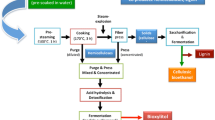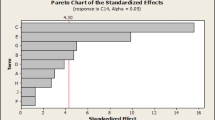Abstract
Candida parapsilosis was grown for 59 h in a medium containing corn cob hydrolysate consisting of 50 g xylose l−1, 3.0 g glucose l−1, 2.0 g arabinose l−1, and 0.9 g acetic acid l−1. A biomass of 9.1 g l−1 was produced with 36 g xylitol l−1 and 2.5 g ethanol l−1. In a medium containing 50 g xylose l−1 instead of corn cob hydrolysate, the concentrations of cells, xylitol, and ethanol were 8.6 g l−1, 33 g l−1, and 0.2 g l−1, respectively. The differences between two cultures were due to the glucose and arabinose in the corn cob hydrolysate stimulating growth and the low concentration of acetic acid stimulating xylitol production.
Similar content being viewed by others
References
Chen LF, Gong CS (1985) Fermentation of sugar cane bagasse hydrolysate-acclimatized yeast. J. Food. Sci. 50: 226–228.
Ferrari MD, Neirotti E, Albornoz C, Saucedo E (1992) Ethanol production from Eucalyptus wood hemicellulose hydrolysate by Pichia stipitis. Biotechnol. Bioeng. 40: 753–759.
Hahn-Hägerdal B, Jeppsson H, Skoog K, Prior BA (1994) Biochemistry and physiology of xylose fermentation by yeasts. Enzyme Microbiol. Tech. 16: 933–943.
Heikkilä H, Nurmi J, Rahkila L, Töyrylä L (1992) Method for the production of xylitol. US Patent 5,081,026.
Lee YY, McCaskey TA (1983) Hemicellulose hydrolysis and fermentation of resulting pentoses to ethanol. Tappi J. 66: 102–107.
Mäkinen KK (1979) Xylitol and oral health. Adv. Food. Res. 25: 137–180.
Noda F, Hayashi K, Mizunuma T (1982) Influence of pH on inhibitory activity of acetic acid on osmophilic yeasts used in brine-fermentation of soy sauce. Appl. Environ. Microbiol. 43: 245–246.
Oh DK, Kim SY (1998) Increase of xylitol yield by feeding xylose and glucose in Candida tropicalis. Appl. Microbiol. Biotechnol. 50: 419–425.
Oh DK, Kim SY, Kim JH (1998) Increase of xylitol production rate by controlling redox potential in Candida prapsilosis. Biotechnol. Bioeng. 58: 440–444.
Parajo JC, Dominguez H, Dominguez JM (1996) Production of xylitol from concentrated wood hydrolysates by Debaryomyces hansenii: effect of the initial cell concentration. Biotechnol. Lett. 18: 593–598.
Roberto IC, Mancilha IM, de Souza CA, Felipe MGA, Sato S, de Castro HF (1994) Evaluation of rice straw hemicellulose hydrolysates in the production of xylitol fermentation by Candida guilliermondii. Biotechnol. Lett. 16: 1211–1216.
van Zyl C, Prior BA, du Preez JC (1988) Production of ethanol from sugar cane baggasse hemicellulose hydrolysate by Pichia stipitis. Appl. Biochem. Biotechnol. 17: 357–369.
Wäler SM, Assev S, Rolla G (1992) Xylitol-5-phosphate formation by dental plaque after 12 week's exposure to a xylitol/sorbitol containing chewing gum. J. Dent. Res. 100: 319–321.
Author information
Authors and Affiliations
Rights and permissions
About this article
Cite this article
Kim, SY., Oh, DK. & Kim, JH. Evaluation of xylitol production from corn cob hemicellulose hydrolysate by Candida parapsilosis . Biotechnology Letters 21, 891–895 (1999). https://doi.org/10.1023/A:1005574624617
Issue Date:
DOI: https://doi.org/10.1023/A:1005574624617




